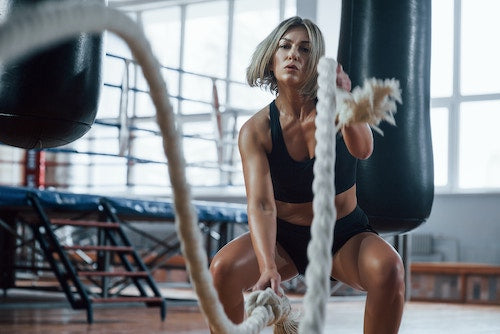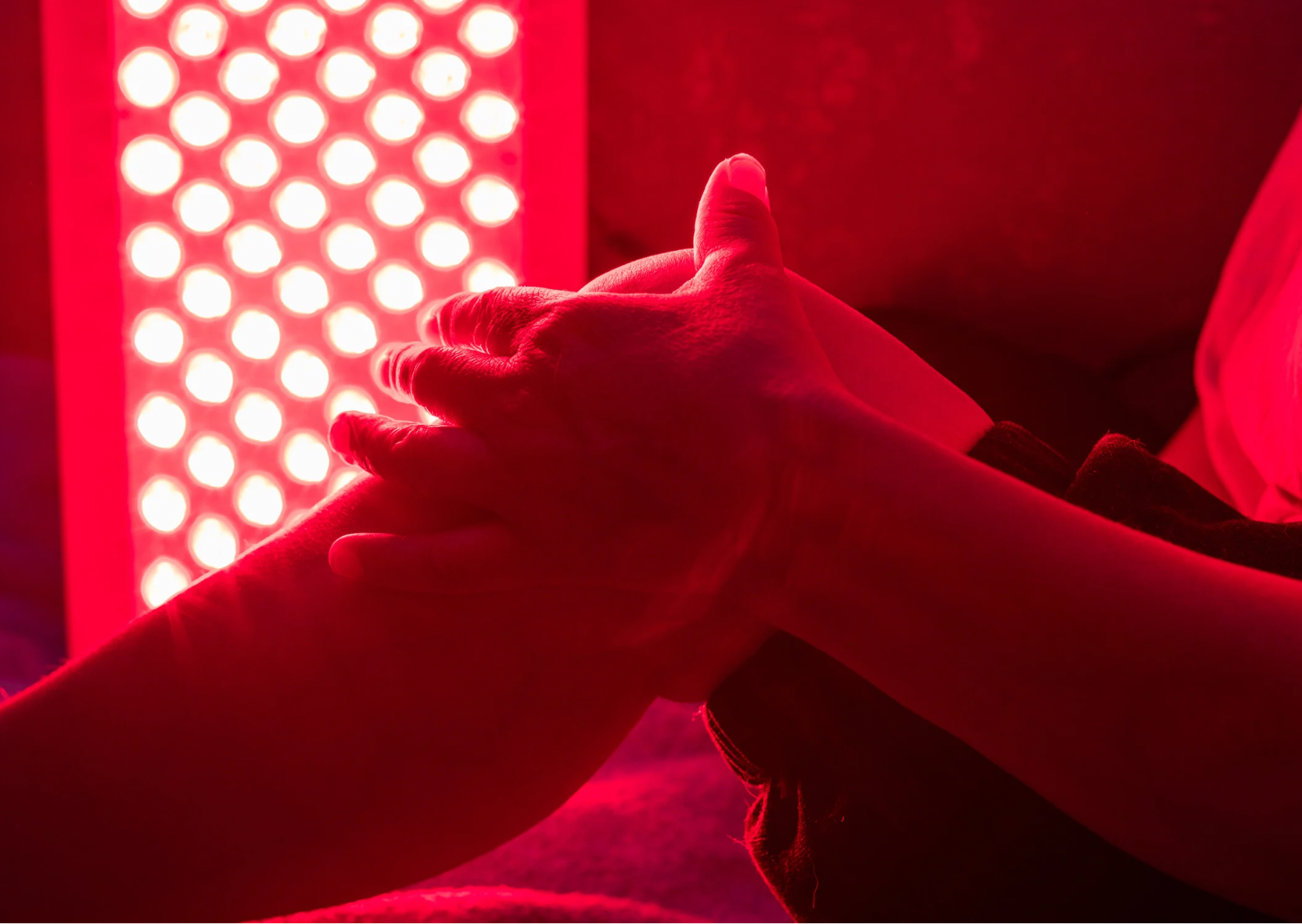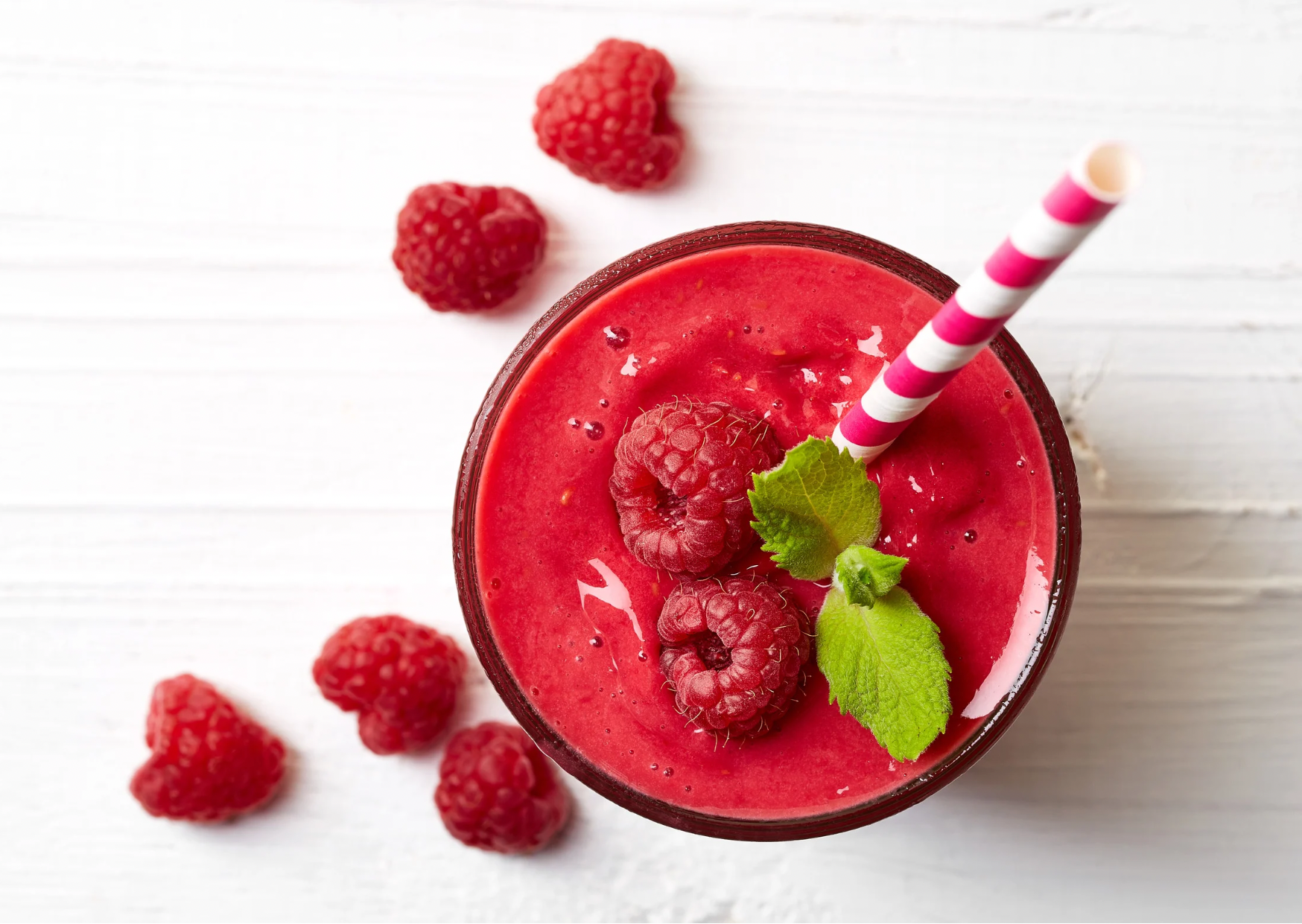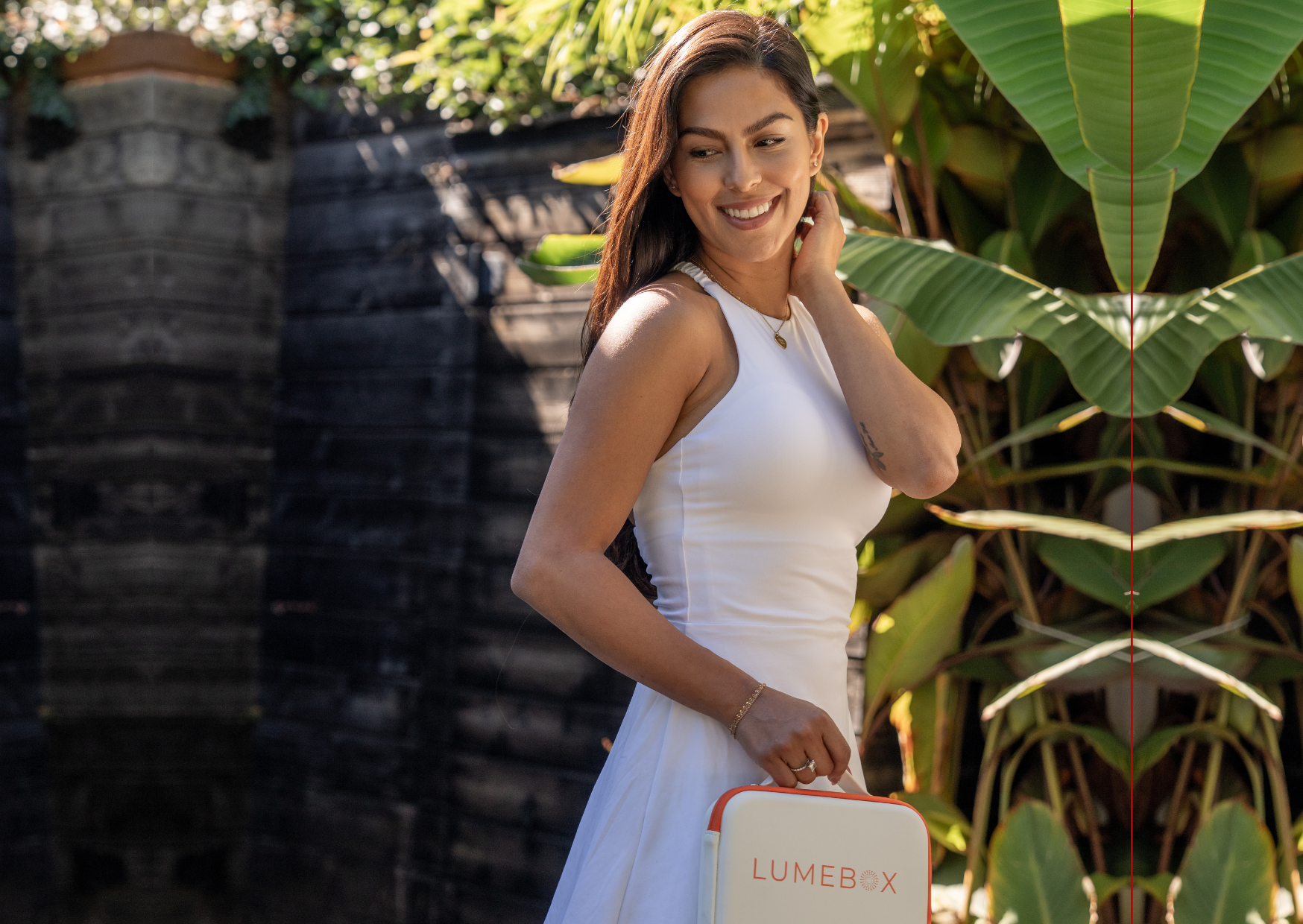What do the 49ers, Under Armour, and the Pittsburgh Steelers have in common?
They all use red light therapy to elevate their athletes’ performance. (And for good reason!) But don't think this technology is just for the pros. Whether you're a dedicated athlete or simply committed to a healthier you, red light therapy could help unlock your full potential and help with that post-workout soreness.
Enhance Athletic Performance
Let's begin by exploring how red light therapy can supercharge your athletic performance. Think back to any of the times you've pushed your limits during a workout, chased that personal best, or tried to outdo your last session.
It's tough.
It can feel like an uphill battle. But what if you had a secret weapon to boost your energy, endurance, and overall performance?
Studies have shown that red light therapy may have the power to do just that. Professional athletes are already integrating this cutting-edge technology into their training routines to get that extra edge in their performance. Whether it's achieving higher reps, running that extra mile, or enduring those intense HIIT sessions, red light therapy has your back.
How It Works:
In order for our muscles to contract - muscle cells need energy.
Where does this energy come from? Our Mitochondria.
The mighty mitochondria inside our cells turn the food we eat into energy the cell can then use. Muscles are particularly dense in mitochondria, and the more mitochondria you have, the better your muscles can perform.
This is where red light therapy comes in. It helps our mitochondria work better! This boost in ATP production enhances our cells' ability to function optimally, leading to improved performance.
That’s all well and good - but does the research back it up?
Let’s take a deep dive - stay with us because we are about to get nerdy.
The Science:
This randomized [1] triple-blind, placebo-controlled crossover trial involving 22 male soccer players from the same team showed red light therapy enhanced athletic performance and improved post exercise recovery.
The athletes underwent both active PBMT (using 810nm laser) and a placebo treatment. After these treatments, they participated in a high-intensity progressive running test until exhaustion.
The results showed that PBMT had several positive effects on the athletes' performance and physiological markers. It increased their maximum oxygen uptake (VO2 max), time until exhaustion, and thresholds for aerobic and anaerobic exercise. Additionally, PBMT reduced the activities of creatine kinase (CK) and lactate dehydrogenase (LDH), which are indicators of muscle damage. It also lowered the levels of interleukin-6 (IL-6), an inflammatory marker (i.e. reduced muscle damage and lower inflammation post workout).
One important note is that one of the authors of the study receives research support from a laser device manufacturer. The remaining authors however, have no such conflict of interest.
This study [2] showed LED therapy helped to reduce muscle fatigue and increased the number of repetitions performed.
They enlisted 34 resistance-training athletes who participated in four trials with randomized durations of 30, 60, or 120 seconds, and 660nm and 850nm LEDs on various points on their quadricep muscles.
The study's results revealed those who received LEDT for 60 seconds and 120 seconds showed an increased number of repetitions performed on each quadriceps compared to placebo. (p=-0.004 for the 60 second group, p=0.023 for the 120 second group) showing that LEDT can have a positive impact on performance by reducing muscular fatigue.
This study [3] looked at the performance and recovery of high-level rugby players during an anaerobic field test. Twelve male athletes participated in a randomized, double-blind, placebo-controlled trial.
During the study, PBMT was applied to 17 sites on each lower limb using a cluster containing 12 LEDs at different wavelengths. This was done pre-exercise in two of the testing weeks, while a placebo was used in the other week. The researchers evaluated various factors, including sprint times, blood lactate levels, and perceived fatigue.It improved the average sprint times and reduced the fatigue index during the field test. PBMT also led to a decrease in blood lactate levels and perceived fatigue.
Unlock Muscle Gains and Hypertrophy
For those of you aiming to sculpt your dream physique and pack on muscle, red light therapy might be the missing puzzle piece. It's like having a personal trainer that helps you achieve more significant gains in less time.
Research (see below) demonstrates that red light therapy can aid in hypertrophy, which is essentially muscle growth. Imagine your muscles responding more efficiently to your workouts, leading to increased muscle mass and strength. It's like turning on the turbo boost for your body's natural muscle-building processes.
How it works:
It is thought that red light therapy enhances blood flow to your muscles, which means more oxygen and nutrients are delivered to your muscle fibers. This increased circulation not only helps muscles recover faster but also promotes muscle growth.
The Science:
A randomized, double blind, placebo-controlled, crossover trial on 10 pro volleyball players [7] studied the effects of red LED therapy on exercise-induced muscle fatigue, assessing how many repetitions subjects could carry out until failure. They compared a red light therapy group with a placebo group, delivering red and near-infrared LED light at 660nm (50mW/cm2) and 850 nm (150 mW/cm2) for 30 seconds, applied directly to the middle of the biceps immediately before exercise. Exercise in this case was bicep curls.
LED therapy led to an increase in the number of bicep contractions by 13% compared to the placebo, and also decreased blood lactate (the acidic waste product from exercise that leads to soreness), creatine kinase (a product of muscle breakdown), and C-reactive protein (a marker of inflammation).
In a randomized and triple-blinded study, twenty-two older women participated in a 10-week resistance training (RT) program, performing leg extension exercises. Each participant's legs were randomly assigned to receive either active laser photobiomodulation (PBM) or a placebo laser treatment before RT sessions.
The results showed that both active laser and placebo laser conditions led to similar improvements in muscle hypertrophy, strength, and postural balance over the course of the training program. However, when considering muscle hypertrophy specifically, the active laser treatment showed a moderate effect, while the placebo laser had a smaller effect. Overall, this suggests that RT alone can have significant benefits for countering age-related muscle deterioration, and adding laser PBM therapy before RT sessions may further enhance muscle hypertrophy gains. [4]
This review [5] examined the impact of photobiomodulation (PBM) on human muscle tissue in clinical trials related to sports performance in both regular volunteers and athletes. It looked at various performance metrics such as fatigue, muscle damage, recovery, and muscle-related parameters. A total of 46 studies with 1,045 participants were included in the review.
The results suggest that PBM can enhance muscle growth following training, reduce inflammation, and alleviate oxidative stress in muscle tissues. The review also raises the question of whether PBM should be allowed in competitive sports, prompting consideration by international regulatory authorities. [5]
Accelerate Post-Workout Recovery
Now, let's talk about that post-workout soreness. We've all been there – those days when it's hard to get out of bed after a grueling exercise session. Red light therapy comes to the rescue again, offering a solution that can cut down your downtime and get you back in the game faster.
Studies have shown that red light therapy reduces muscle damage, inflammation, and oxidative stress caused by intense workouts. In simpler terms, it means you'll experience less soreness, recover more quickly, and be ready to hit the gym sooner for your next killer workout.
How It Works:
Red light therapy has an anti-inflammatory effect on the body, reducing the production of pro-inflammatory molecules and increasing anti-inflammatory ones. It also enhances the body's ability to repair and regenerate tissues, helping muscles heal faster.
The Science:
Photobiomodulation therapy (PBMT) has emerged as a promising alternative to the commonly used cryotherapy, but the question that drove this review [6] was whether PBMT outperforms cryotherapy in reducing recovery time and alleviating delayed onset muscle soreness after demanding physical activity. The review of the available evidence uncovered three high-quality double-blinded, randomized, placebo-controlled trials and two moderate-quality translational studies conducted on rats.
Remarkably, all five of these studies consistently favored PBMT over cryotherapy for post-exercise muscle recovery. PBMT exhibited superiority in reducing markers of inflammation, creatine kinase, and blood lactate when compared to cryotherapy, especially following intense aerobic or strength exercises. The benefits of PBMT, including shorter recovery times and improved muscle performance, can manifest within 24 to 96 hours after its application and suggest PBMT is a more effective approach to enhancing skeletal muscle recovery after exercise.
Another good example is this randomized, double-blind, controlled trial that studied the effect of red (660 nm) and near-infrared LED light (880 nm) on Delayed Onset Muscle Soreness (DOMS) [8]. DOMS is muscle pain or soreness experienced after a workout, usually a day or two later.
In this study, 27 subjects were split into 3 groups to receive either LED therapy, a placebo, or the control treatment. The participants carried out elbow flexions and received light treatment to 3 points along the bicep immediately after exercise. The light used 4 RED LEDs and 32 NIR LEDs, delivering 100mW/cm2 for 1 minute 20 seconds in direct contact with the skin.
This treatment was given for 5 consecutive days, and on days 2-5, pain was assessed using a VAS scale and the McGill Pain Questionnaire.
Their results showed that after exercise, pain associated with DOMS in the light treatment group significantly decreased after 48 h compared to the control and sham groups.
Conclusion
Whether you're an elite athlete aiming for peak performance or a fitness enthusiast on a quest for a healthier, stronger you, the power of red light therapy is within your reach.
If you’re looking for an affordable, portable option to rotate into your fitness routine, harness the power of red light therapy on the go, LUMEBOX has you covered.
New to red light therapy? Download our free eBook to help you choose the best device.
Already have a LUMEBOX? Download our 6 time-saving tricks guide!
Medical Disclaimer: The information contained in this blog post is intended for educational purposes only and should not be used as medical advice. Everyone responds to light differently. Testimonials are not a guarantee of the results you or anyone who uses LUMEBOX will get because your success depends entirely on your circumstances, and the studies on red light therapy shared were not specifically performed using LUMEBOX. Please check with your doctor before using red light therapy and do not change your medical treatments or lifestyle without consulting your physician first.
References:
[1] Tomazoni, S. S., Machado, C. D. S. M., De Marchi, T., Casalechi, H. L., Bjordal, J. M., de Carvalho, P. T. C., & Leal-Junior, E. C. P. (2019). Infrared Low-Level Laser Therapy (Photobiomodulation Therapy) before Intense Progressive Running Test of High-Level Soccer Players: Effects on Functional, Muscle Damage, Inflammatory, and Oxidative Stress Markers-A Randomized Controlled Trial. Oxidative medicine and cellular longevity, 2019, 6239058. https://doi.org/10.1155/2019/6239058
[2] Hemmings, T. J., Kendall, K. L., & Dobson, J. L. (2017). Identifying Dosage Effect of Light-Emitting Diode Therapy on Muscular Fatigue in Quadriceps. Journal of strength and conditioning research, 31(2), 395–402. https://doi.org/10.1519/JSC.0000000000001523
[3] Pinto, H. D., Vanin, A. A., Miranda, E. F., Tomazoni, S. S., Johnson, D. S., Albuquerque-Pontes, G. M., Aleixo, I. O., Junior, Grandinetti, V. D., Casalechi, H. L., de Carvalho, P. T., & Leal-Junior, E. C. (2016). Photobiomodulation Therapy Improves Performance and Accelerates Recovery of High-Level Rugby Players in Field Test: A Randomized, Crossover, Double-Blind, Placebo-Controlled Clinical Study. Journal of strength and conditioning research, 30(12), 3329–3338. https://doi.org/10.1519/JSC.0000000000001439
[4] Rodrigues, C. P., Jacinto, J. L., Roveratti, M. C., Merlo, J. K., Soares-Caldeira, L. F., Silva Ribeiro, A., Nunes, J. P., Junior, E. O., & Aguiar, A. F. (2022). Effects of Photobiomodulation/Laser Therapy Combined With Resistance Training on Quadriceps Hypertrophy and Strength, and Postural Balance in Older Women: A Randomized, Triple-Blinded, Placebo-Controlled Study. Journal of geriatric physical therapy (2001), 45(3), 125–133. https://doi.org/10.1519/JPT.0000000000000313
[5] Ferraresi, C., Huang, Y. Y., & Hamblin, M. R. (2016). Photobiomodulation in human muscle tissue: an advantage in sports performance?. Journal of biophotonics, 9(11-12), 1273–1299. https://doi.org/10.1002/jbio.201600176
[6] Fisher, S. R., Rigby, J. H., Mettler, J. A., & McCurdy, K. W. (2019). The Effectiveness of Photobiomodulation Therapy Versus Cryotherapy for Skeletal Muscle Recovery: A Critically Appraised Topic. Journal of sport rehabilitation, 28(5), 526–531. https://doi.org/10.1123/jsr.2017-0359
[7] Leal Junior, E. C., Lopes-Martins, R. A., Rossi, R. P., De Marchi, T., Baroni, B. M., de Godoi, V., Marcos, R. L., Ramos, L., & Bjordal, J. M. (2009). Effect of cluster multi-diode light emitting diode therapy (LEDT) on exercise-induced skeletal muscle fatigue and skeletal muscle recovery in humans. Lasers in surgery and medicine, 41(8), 572–577. https://doi.org/10.1002/lsm.20810
[8] Douris, P., Southard, V., Ferrigi, R., Grauer, J., Katz, D., Nascimento, C., & Podbielski, P. (2006). Effect of phototherapy on delayed onset muscle soreness. Photomedicine and laser surgery, 24(3), 377–382. https://doi.org/10.1089/pho.2006.24.377




